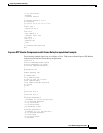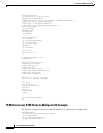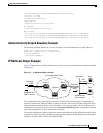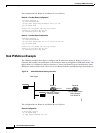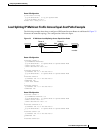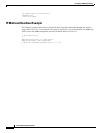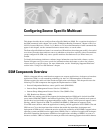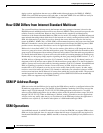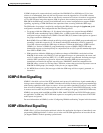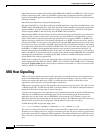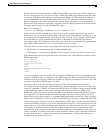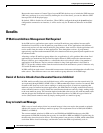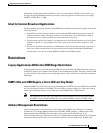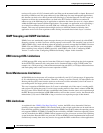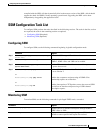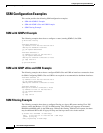
Configuring Source Specific Multicast
IGMPv3 Host Signalling
IPC-461
Cisco IOS IP Configuration Guide
If SSM is deployed in a network already configured for PIM-SM (Cisco IOS Release 12.0 or later
releases is recommended), then only the last hop routers must be upgraded to a Cisco IOS software
image that supports SSM. Routers that are not directly connected to receivers do not have to upgrade to
a Cisco IOS software image that supports SSM. In general, these nonlast hop routers must only run
PIM-SM in the SSM range, and may need additional access control configuration to suppress MSDP
signalling, registering, or PIM-SM shared tree operations from occurring within the SSM range.
The SSM mode of operation is enabled by configuring the SSM range through the ip pim ssm global
configuration command. This configuration has the following effects:
• For groups within the SSM range, (S, G) channel subscriptions are accepted through IGMPv3
INCLUDE mode membership reports, IGMP v3lite, or URD (each of these methods must be
configured on a per-interface basis). IGMP v3lite and URD (S, G) channel subscriptions are ignored
for groups outside the SSM range.
Both IGMP v3lite and URD are based on utilizing existing application IGMP group membership and
extending it with their respective (S, G) channel subscription mechanism, which is ignored by
Cisco IOS software outside the SSM range of addresses. Within the SSM range, IGMP Version 1
(IGMPv1) or Version 2 (IGMPv2) group membership reports or IGMPv3 EXCLUDE mode
membership reports are acted upon only in conjunction with an (S, G) specific membership report
from URD or IGMP v3lite.
• PIM operations within the SSM range of addresses change to PIM-SSM, a mode derived from
PIM-SM. In this mode, only PIM (S, G) join and prune messages are generated by the router, and
no (S, G) rendezvous point tree (RPT) or (*, G) RPT messages are generated. Incoming messages
related to RPT operations are ignored or rejected and incoming PIM register messages are
immediately answered with register-stop messages. PIM-SSM is backward compatible with
PIM-SM, unless a router is a last hop router. Therefore, routers that are not last hop routers can run
PIM-SM for SSM groups (for example, if they do not yet support SSM).
• No MSDP Source-Active (SA) messages within the SSM range will be accepted, generated, or
forwarded.
IGMPv3 Host Signalling
IGMPv3 is the third version of the IETF standards track protocol in which hosts signal membership to
last hop routers of multicast groups. IGMPv3 introduces the ability for hosts to signal group membership
with filtering capabilities with respect to sources. A host can either signal that it wants to receive traffic
from all sources sending to a group except for some specific sources (called EXCLUDE mode), or that
it wants to receive traffic only from some specific sources sending to the group (called INCLUDE mode).
IGMPv3 can operate with both ISM and SSM. In ISM, both EXCLUDE and INCLUDE mode reports
are applicable. In SSM, only INCLUDE mode reports are accepted by the last hop router. EXCLUDE
mode reports are ignored.
For more information on IGMPv3, see the “Configuring IP Multicast Routing” chapter in this document.
IGMP v3lite Host Signalling
IGMP v3lite is a Cisco-developed transitional solution for application developers to immediately start
programming SSM applications. It allows you to write and run SSM applications on hosts that do not
yet support IGMPv3 in their operating system kernel.



